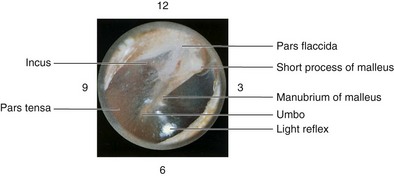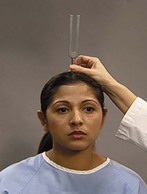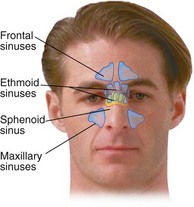TECHNIQUE |
FINDINGS |
|---|
EARS |
Inspect auricles and mastoid area |
Examine lateral and medial surfaces and surrounding tissue. |
|
|
|
 Size/shape/symmetry Size/shape/symmetry |
EXPECTED:Familial variations. Auricles of equal size and similar appearance. Darwin tubercle. |
UNEXPECTED:Unequal size or configuration. Cauliflower ear and other deformities. |
 Lesions Lesions |
UNEXPECTED:Moles, cysts or other lesions, nodules, or tophi. |
 Color Color |
EXPECTED:Same color as facial skin. |
UNEXPECTED:Blueness, pallor, or excessive redness. |
 Position Position
Draw imaginary line between inner canthus and most prominent protuberance of occiput. Draw imaginary line perpendicular to first line and anterior to auricle. |
EXPECTED:Top of auricle touching or above horizontal line. Vertical position. |
UNEXPECTED:Auricle positioned below line (low-set); unequal alignment. Lateral posterior angle greater than 10 degrees. |
 Preauricular area Preauricular area |
EXPECTED:Preauricular pits, skin tags, or smooth skin. |
UNEXPECTED:Openings in preauricular area, discharge. |
 External auditory canal External auditory canal |
EXPECTED:No discharge, no odor; canal walls pink. |
UNEXPECTED:Serous, bloody, or purulent discharge; foul smell. |
Palpate auricles and mastoid area |
|
EXPECTED:Firm and mobile, readily recoils from folded position; no tenderness in postauricular or mastoid area. |
UNEXPECTED:Tenderness, swelling, nodules. Pain when pulling on lobule. |
Inspect auditory canal with otoscope |
|
EXPECTED:Minimal cerumen in varying color and texture. Uniformly pink canal. Hairs in outer third of canal. |
UNEXPECTED:Cerumen obscures tympanic membrane, odor, lesions, discharge, scaling, excessive redness, foreign body. |
Inspect tympanic membrane |
 Landmarks Landmarks
Vary light direction to observe entire membrane and annulus. |
EXPECTED:Visible landmarks (umbo, handle of malleus, light reflex). |
UNEXPECTED:Perforations, landmarks not visible. |
 Color Color |
EXPECTED:Translucent, pearly gray. |
UNEXPECTED:Amber, yellow, blue, deep red, chalky white, dull, white flecks, or dense white plaques; air bubbles or fluid level. |
|
|
Contour |
EXPECTED:Slightly conical with concavity at umbo. |
UNEXPECTED:Bulging (more conical, usually with loss of bony landmarks and distorted light reflex) or retracted (more concave, usually with |
|
accentuated bony landmarks and distorted light reflex). |
Mobility
Seal canal with speculum, and gently apply positive (squeeze) and negative (release) pressure with pneumatic attachment. |
EXPECTED:Movement in and out. |
UNEXPECTED:No movement. |
Assess hearing |
 Questions during history Questions during history |
EXPECTED:Responds to questions appropriately. |
UNEXPECTED:Excessive requests for repetition. Speech with monotonous tone and erratic volume. |
 Whispered voice Whispered voice
Have patient mask hearing in one ear by inserting a finger in ear canal. Stand 1 to 2 feet from other ear and softly whisper three letter and number combinations (e.g., 3, T, 9 or 5, M, 2). Use a different letter number combination in other ear. |
EXPECTED:Patient repeats numbers and letters correctly more than 50% of time. |
UNEXPECTED:Patient unable to repeat whispered words. |
 Weber test Weber test
Place base of vibrating tuning fork on midline vertex of head. Repeat with one ear occluded. |
EXPECTED:Sound heard equally in both ears (unoccluded). Sound heard better in occluded ear. |
UNEXPECTED:See table on p. 84. |
|
|
 Size/shape/symmetry
Size/shape/symmetry Lesions
Lesions Color
Color Preauricular area
Preauricular area External auditory canal
External auditory canal Color
Color Questions during history
Questions during history Shape/size
Shape/size Color
Color Nares
Nares Color
Color Shape
Shape Condition
Condition

 Get Clinical Tree app for offline access
Get Clinical Tree app for offline access








 Position
Position Landmarks
Landmarks
 Whispered voice
Whispered voice Weber test
Weber test
 Rinne test
Rinne test


